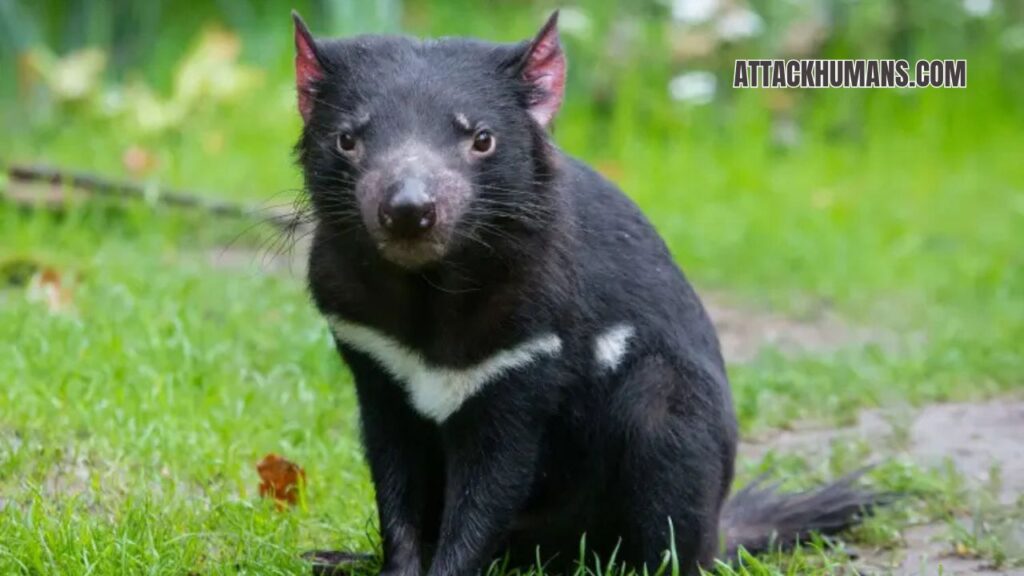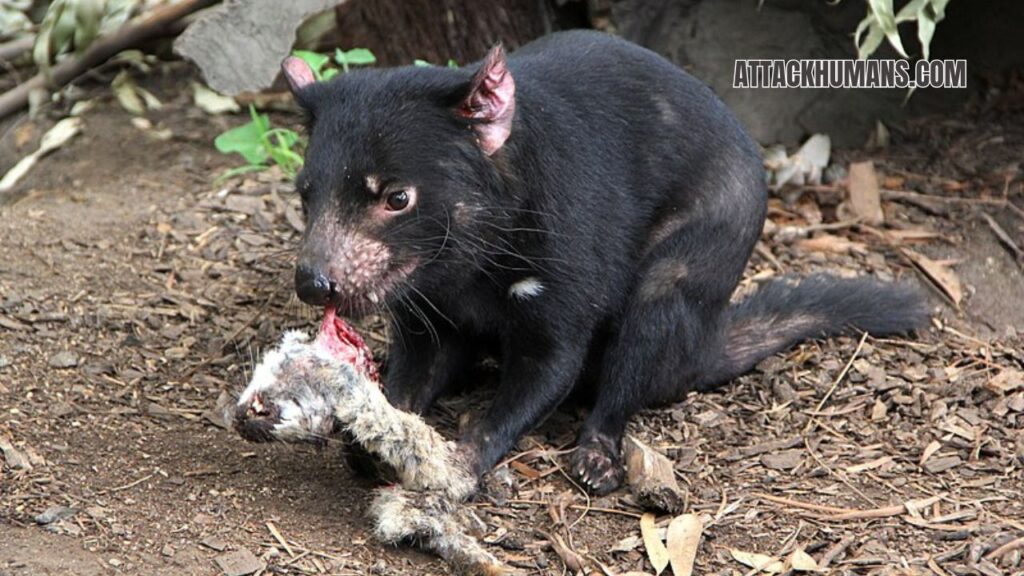Do Tasmanian Devils Attack Humans? Tasmanian devils are generally not a threat to humans and avoid interactions, but they may bite if cornered or threatened.
Tasmanian devils, the world’s largest carnivorous marsupials, have long captured the fascination and curiosity of animal lovers worldwide.
With their powerful jaws, unique vocalizations, and fierce reputation, these creatures are often misunderstood. [Do Tasmanian Devils Attack Humans?]
For those unfamiliar with their behavior, Tasmanian devils can seem intimidating. However, despite their fearsome appearance, Tasmanian devils are not typically a threat to humans.
In this article, we’ll dive into the question of whether Tasmanian devils attack humans, discuss the circumstances under which they might exhibit aggressive behavior, and provide some insights into safely interacting with these fascinating animals.
Contents
2. What Are Tasmanian Devils?
A. Physical Characteristics
Tasmanian devils are small, muscular creatures with a unique appearance that makes them easily recognizable.
Their black fur is often marked with white patches on the chest and rump, giving each animal a distinct look. [Do Tasmanian Devils Attack Humans?]
Adults generally weigh between 15 and 25 pounds, standing about 12 inches tall at the shoulder and measuring 20-30 inches in length, excluding their tail.
Tasmanian devils are equipped with sharp teeth and extremely powerful jaws, capable of exerting one of the strongest bites relative to their body size among all land mammals.
This enables them to consume almost every part of a carcass, including bones, which is an adaptation essential for their scavenger lifestyle.
B. Habitat and Behavior
Tasmanian devils are found exclusively on the island of Tasmania, where they inhabit various environments, from coastal heath to dry woodland.
They are nocturnal creatures, meaning they are most active during the night when they hunt and scavenge for food. Although they primarily feed on carrion, Tasmanian devils are also capable hunters and may occasionally catch small prey like birds, frogs, and fish.
Their preference for nocturnal activity means they generally avoid human interaction, especially during daylight hours.
In the wild, Tasmanian devils are solitary animals that prefer to roam independently rather than in groups. [Do Tasmanian Devils Attack Humans?]
They are known for their loud screeches, which can sound unsettling but serve as a means of communication, particularly during feeding.
Tasmanian devils are territorial, and their vocalizations help them assert dominance and ward off competitors from their food sources.

3. Are Tasmanian Devils Dangerous to Humans?
A. Defensive Nature
Generally, Tasmanian devils are more inclined to flee than to fight when confronted by a potential threat. [Do Tasmanian Devils Attack Humans?]
They are naturally shy animals that avoid human contact whenever possible. While they can display aggressive behaviors, such as growling, lunging, or biting, these actions are typically defensive rather than predatory.
They are primarily aimed at protecting themselves or their food. Because of their strong jaws and sharp teeth, Tasmanian devils are capable of inflicting a painful bite if they feel cornered or trapped. However, they are unlikely to attack unprovoked.
B. Circumstances of Aggression
While rare, there are specific situations in which a Tasmanian devil might display aggressive behavior toward humans.
These situations generally arise when the animal feels threatened, cornered, or otherwise unable to escape. [Do Tasmanian Devils Attack Humans?]
For example, if a person were to approach a Tasmanian devil closely, especially one that is eating, the animal might react defensively.
Additionally, juvenile Tasmanian devils, like many young animals, can sometimes be more skittish and prone to react aggressively if they are startled.
C. Misconceptions vs. Reality
Due to their snarling and screeching sounds, Tasmanian devils have garnered a reputation for being highly aggressive and dangerous.
However, this reputation is largely based on misunderstandings. The vocalizations and displays of aggression are primarily intended to communicate with other devils rather than to threaten humans.
While they might seem fierce, Tasmanian devils are primarily scavengers and only engage in confrontations as a last resort.
Their natural behavior is actually much more passive than their reputation suggests. [Do Tasmanian Devils Attack Humans?]
D. Recorded Incidents of Attacks
Though documented instances of Tasmanian devils attacking humans are exceedingly rare, there have been occasional reports, generally involving bites during close interactions.
These incidents typically involve individuals who have attempted to handle or corner a Tasmanian devil, leading the animal to respond defensively.
In these cases, the attacks are not driven by predation or aggression but rather by the animal’s instinct to protect itself. There is no evidence to suggest that Tasmanian devils pose a genuine threat to humans in everyday situations.
E. Comparing Tasmanian Devils to Other Wild Animals
Compared to other wild animals, particularly larger predators, Tasmanian devils pose a relatively low risk to humans.
Unlike animals such as crocodiles, sharks, or snakes, Tasmanian devils do not actively pursue humans or pose any significant danger under normal circumstances.
Their primary concern is food, and they are more interested in scavenging than in hunting or engaging with humans.
In this way, Tasmanian devils are far less threatening than many other species that inhabit Australia and its surrounding islands.
4. Why Tasmanian Devils Rarely Attack Humans
A. Natural Instincts and Diet
Tasmanian devils are scavengers by nature, meaning their primary diet consists of carrion, or the remains of dead animals.
Their role in the ecosystem is vital, as they help to clean up carcasses, thereby reducing the spread of disease. [Do Tasmanian Devils Attack Humans?]
Unlike predators that actively seek live prey, Tasmanian devils have little incentive to target humans. Their strong jaws and teeth are adapted for consuming tough material like bone and hide, not for attacking or hunting large, live animals.
As a result, humans do not resemble their food sources, and Tasmanian devils do not view humans as potential prey.
B. Fear of Humans
Tasmanian devils have evolved with a natural wariness of humans, largely due to their nocturnal habits and limited interactions with people.
Human activity tends to occur during daylight hours, whereas Tasmanian devils are most active after dark. This schedule naturally limits their encounters with humans.
Additionally, the relatively low population density in Tasmania means that Tasmanian devils are not frequently exposed to people, which has likely reinforced their instinct to avoid human contact.

5. How to Stay Safe Around Tasmanian Devils
A. Best Practices for Wildlife Encounters
When encountering Tasmanian devils in the wild, the most important thing is to remain calm and give them plenty of space. [Do Tasmanian Devils Attack Humans?]
Avoid approaching them directly, especially if they appear to be eating or showing signs of agitation.
Observing from a distance not only minimizes any potential risk but also allows you to watch these fascinating animals in their natural environment without disturbing them.
B. What to Do if Threatened
In the unlikely event that you find yourself in close proximity to a Tasmanian devil and it begins to act defensively, the best approach is to back away slowly.
Do not turn your back on the animal or make sudden movements, as this could provoke a reaction. Instead, maintain eye contact and slowly create distance.
Making a bit of noise, such as clapping or speaking in a loud voice, can help to discourage the animal from approaching.
C. Understanding Tasmanian Devil Conservation
Tasmanian devils are an endangered species, facing significant challenges due to the spread of Devil Facial Tumor Disease (DFTD), a contagious cancer that has decimated their population.
Conservation efforts are underway to protect and rehabilitate Tasmanian devil populations.
As a result, it’s crucial for humans to respect these animals and avoid actions that could disrupt their environment. [Do Tasmanian Devils Attack Humans?]
If you encounter a Tasmanian devil in the wild, consider the importance of preserving their habitat and avoid disturbing them unnecessarily.
See Also: Do Sand Sharks Attack Humans?
6. Final Verdict
Tasmanian devils are not generally dangerous to humans and are unlikely to attack without significant provocation. [Do Tasmanian Devils Attack Humans?]
While they possess strong jaws and a powerful bite, they typically reserve these for their prey and for defensive purposes.
Encounters with Tasmanian devils can be a unique and memorable experience, provided you give them the respect and space they need.
By understanding their behavior and role within the ecosystem, we can coexist peacefully with these unique animals and contribute to their conservation.
7. FAQs
Q1: Are Tasmanian devils aggressive towards people?
No, Tasmanian devils are typically shy and avoid human interactions. They only show aggression when they feel threatened or cornered.
Q2: What should I do if I see a Tasmanian devil?
Remain calm and avoid sudden movements. Keep a respectful distance and allow the animal to move away on its own.
Q3: How common are Tasmanian devil attacks on humans?
Tasmanian devil attacks on humans are extremely rare and usually occur only in defensive situations.
Q4: Can Tasmanian devils be kept as pets?
No, Tasmanian devils are wild animals and are not suitable as pets. In addition, they are a protected species. [Do Tasmanian Devils Attack Humans?]
Q5: Are Tasmanian devils dangerous to other animals?
While they generally scavenge, they can be dangerous to small animals and are capable of hunting if necessary.
8. Conclusion: Do Tasmanian Devils Attack Humans?
Tasmanian devils, though often misunderstood, are not a significant threat to humans. These nocturnal marsupials prefer a solitary life and have little interest in human interaction.
By respecting their space and observing from a distance, we can safely coexist with these unique and vital members of Tasmania’s ecosystem.
Understanding their behavior, respecting their role as scavengers, and supporting conservation efforts are essential steps in ensuring the survival of the Tasmanian devil.

Hello, I am Rosa Ellis, a mother of two and a wildlife blogger. I grew up in New York City, but I love exploring forests. I’ve traveled to places like Yellowstone National Park and the Amazon Rainforest to see animals up close. I know a lot about animal behavior and which animals can be dangerous to humans. Thanks for visiting my blog!

